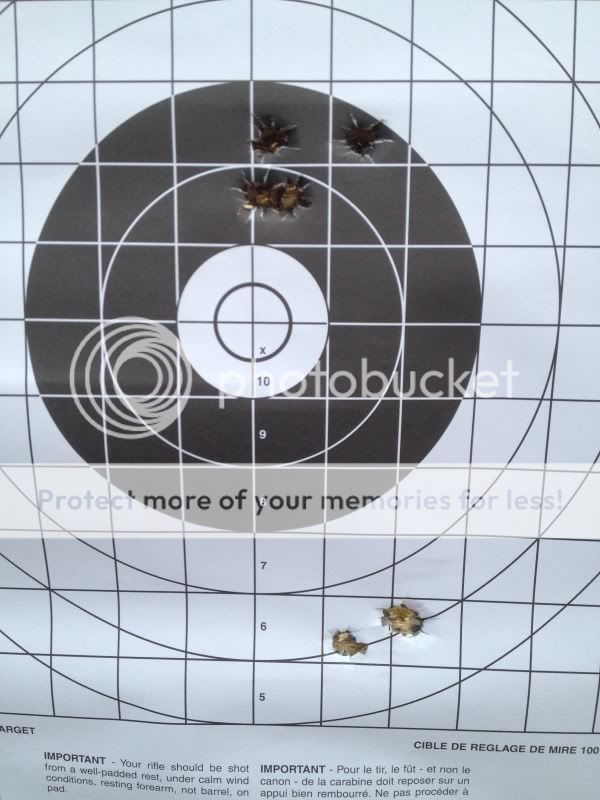Douglas and I have had this discussion before, and I disagree. Tight groups have a purpose, and was alluded to . . . its nice to know, it inspires one's confidence. On the other hand, it can disillusion the shooter if his rifle or load doesn't quite make that magical MOA, and when he forgets what the mission of his rifle really is. Too often shooters claim miraculous accuracy from their hunting rifles, but what happened once is not the same as doing something on demand. I'm not pointing a finger at Douglas, in fact I've never heard him make a claim that wasn't true or that he couldn't back up. But if I went around boasting that my factory full stock CZ-527 could dump them all in one hole at 200 yards, my honesty would be suspect, although it occurred once, and not from the bench or prone, but off the hood of my truck! If only I could do that on demand. So if a rifle is deemed capable of a specific degree of precision, how many groups must then be fireds to determine that is in fact the case, and how many rounds should be fired in each group?
The wisdom of getting away from worrying about tight groups came to me, not when rifle shooting, but on a Ranger exercise when we did a familiarization shoot with the Hi-Power pistol. I'd been a decent pistol shooter for a long time by then, and when my turn came to shoot, I fully expected to clean house as no one else had even held a pistol before. I fired my first shot, asked the GIC to indicate where my first round landed, he obliged, but as it turned out, he lied. So I shot a pretty little group, 2" below my first bullet impact, which was already low, with all the holes touching, into the 8 ring I think it was. I came in second. The gal who beat me scattered her rounds into a wide pattern, but none of her shots extended outside the 9 ring. Ahhh, see, its not the size of the group that wins the day, its the distance your rounds land from your intended point of impact; the length of your shot string. But who measures the length of their shot strings?
So, if your rifle with it's pencil thin barrel, always puts the cold bore shot right on the money and every subsequent round were to open up half a minute, does that mean your rifle is incapable of precision? If you put up a 300 yard target, and fired one shot every morning for 5 days, and that group measured .75 MOA, then I'd say you had something, and that information is nice to know and should inspire confidence. But neither that level of precision, nor the confidence it exuded, would ever be realized by shooting a quick 5 shot or even a 3 shot group. But precision only matters within the parameters of target size, range, environmental conditions, the quality of the ammunition, and time. If you intend to shoot a deer at a half mile, precision is extremely important, but that is, at least for now, well outside the ability of both the typical hunter and his equipment.
When Townsend Whelen measured rifle accuracy at Aberdeen, it was with numerous 20 round groups fired at 300 yards. If he said that such and such a rifle was a 2 minute rifle, that level of precision fell within a very specific definition, and only applied to one lot of ammunition. Certainly that rifle would show better accuracy if it fired a group with fewer shots, and would show better or worse accuracy with a different lot of ammo. Typically 80% of the rounds would be in the 10 ring, yet the overall group size is determined by only 20% of the rounds fired, in fact by the worst two rounds vertically and horizontally of the 20%. What about the other 80%? If you measured your shot string, they'd be taken into account.
Precision in a hunting rifle is frequently determined by firing a 3 shot group. Why? Because under typical hunting conditions its reasonable to assume that it might take 3 rounds to finish the job, despite our preference for one shot kills, and the barrel shouldn't heat up enough to throw a wide shot with 3 rounds. So what of the hunter who fires 15 rounds to put his animal away, should his rifle's level of precision then be determined by 15 shot groups, and if it were, would that provide him with useful information? He and his quarry would be better off had he put in more trigger time that more closely represented true hunting conditions. Some might recognize the name Carlos Hathcock, winner of the Wimbledon Cup and legendary USMC sniper during the Vietnam War. Hathcock carried a heavy barrel .30/06 M-70 Winchester for much of his time in country, and made some startling shots with that rifle. The fact that it was a 2 MOA rifle didn't seem to help Charlie when he caught a round in the face from half a mile away across some rice paddy. The key is that rifle usually put the first round where Hathcock needed it to go.
The information the practical shooter needs under typical big game hunting conditions is the trajectory of his bullet for a given range, relative to his rifle's zero, the wind drift, and the deviation from zero for a high angle shot if he hunts in steep country. Having a good grasp of that information, and the knowledge that the first shot is the money shot, will do more for one's confidence, than a shooting a couple of 1" groups at 100.










































































